Occupational Blood Exposure in Maharat Nakhon Ratchasima Hospital : Analysis of Trend After Implementating Safety Measures
Main Article Content
Abstract
Background: Health care workers (HCWs) are at risk of occupational exposures to bloodborne pathogens. The exposures can lead to serious or fatal infections with hepatitis B virus, hepatitis C virus, or human immuunodeficiency virus. According to the annual surveillance reports, the average incidence of such exposures in Maharat Nakhon Ratchasima hospital during 1993-1999 was 17.0/1,000 risk HCWs. Comparing with the prevalence rate (324.8/1,000 risk HCWs) obtained by cross-sectional survey in the year 2000, the figure is very low.
Objective. To study trend of occupational blood exposure in HCWs after implementing the preventive measures.
Methods: Prospective surveillance study was conducted and preventive efforts were implemented focusing on raising awareness, increasing exposure report, training HCWs, and providing protective devices and appropriate sharps disposal containers. In addition, timely HIV postexposure prophylaxis with follow-up testing and medical evaluation were also given.
Results: During the year 2000-2002, the reports of occupational blood exposure were significantly increased (31.9, 35.7, and 32.5/1,000 risk HCWs respectively) showing the trends toward exposures in medical staff and both medical and nursing students. Most of the events, among which needlestick injuries were the highest, occurred at hospital wards. HCWs were more knowledgeable regarding the risk of exposures and seeked medical advise despite the source persons were seronegative. Analysis of activities associated with needlestick injuries revealed obvious reduction in the ones occurring before disposal.
Conclusions: Implementation of prevention efforts can lcad to safety awareness, increasing occupational blood exposure report, and reducing pre-disposal needlestick injuries. Ready access to counseling and guidance is important for postexposure management.
Article Details

This work is licensed under a Creative Commons Attribution-NonCommercial-NoDerivatives 4.0 International License.
References
NIOSH Alert : Preventing Needlestick Injuries in Health Care Settings.Cincinnati, OH: U.S. Department of Health and Human Service, Public Health Service, Center for Disease Control and Prevention, National Institute for Occupational Safety and Health, DHIHS (NIOSH). Publication No. 2000-108. November 1999.
ศันสนีย์ ธนกิจการ. ปัจจัยที่มีความสัมพันธ์กับการเกิดอุบัติเหตุจากของมีคมในการปฏิบัติงานของพยาบาลประจำการในโรงพยาบาล. จุลสาร ชมรมควบคุบคุมโรคติดเชื้อในโรงพยาบาลแห่งประเทศไทย 2539, 6:8-9.
Center for Disease Control and Prevention. Recommendations for preventing transmission of infection with human T-lymphotropic virus type IlI/ lymphadenopathy-associated virus in the workplace. MMWR 1985;34:681-6,691-5.
Center for Disease Control and Prevention. Recommendations for prevention of HIV transmission in health-care settings. MMWR 1987;36(suppl 2):15-18S.
Garner JS. Guideline for isolation precautions in hospitals. The Hospital Infection Control Practices Advisory Committee. Infect Control Hosp Epidemiol 1996;17:53-80.
Apisarnthanarak A, Fraser VJ . Bloodborne pathorgens and health care workers in developing countries: Risk assessments and preventive strategies. J Infect Dis Antimicrob Agent 2002; 19:65-79.
Monge V, et al. Epidemiology of biological-exposure incidents among spanish healthcare workers. Infect Control Hosp Epidemiol 2001;22:776-80.
Khuri-Bolos N, Toukan A, Mahafzah A, Al Adham M, Faori, Abu Khader I, et al. Epidemiology of needlestick and sharp injuries at a university hospital in a developing country:A 3-year prospective study at the Jordan University Hospital, 1993 through 1995. Am J Infect Control 1997;25:322-9.
Beekmann SE, Vaughn TE, McCoy KD, Ferguson KJ,Torner JC,Woolson RF,et al. Hospital bloodborne pathogens programs: program characteristics and blood and body fluid exposure rates. Infect Control Hosp Epidemiol 2001;22:73-82.
Jackson MA, William K, Olson-Burgess C, Kinney J, Olson LC, Burry VF. Needlestick injuries in a pediatric hospital. Pediatr Infect Dis 1994;13:318-20.
McCormick RD, Meisch MG, Ircink FG, Maki DG. Epidemiology of hospital sharps injuries: a 14-year prospective study in the pre-AIDS and AIDS eras. Am J Med 1991;91 (suppl 3B):301S-307S.
โรงพยาบาลมหาราชนครราชสีมา. นโยบายและวิธีปฏิบัติเรื่องการใช้เครื่องปกป้องร่างกาย (Barrier Precautions). 2546.


